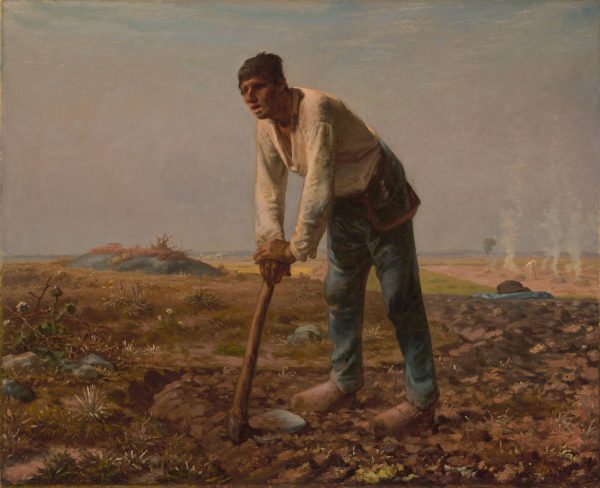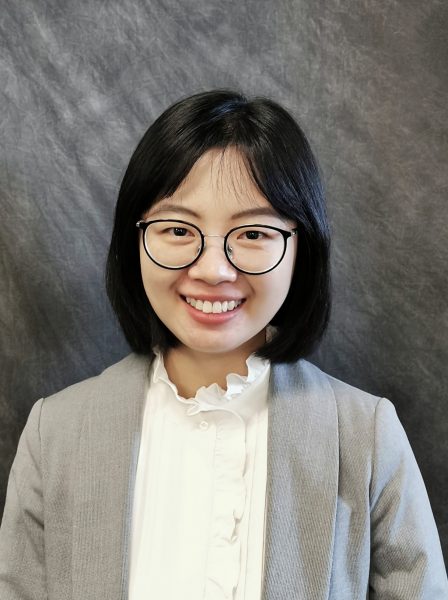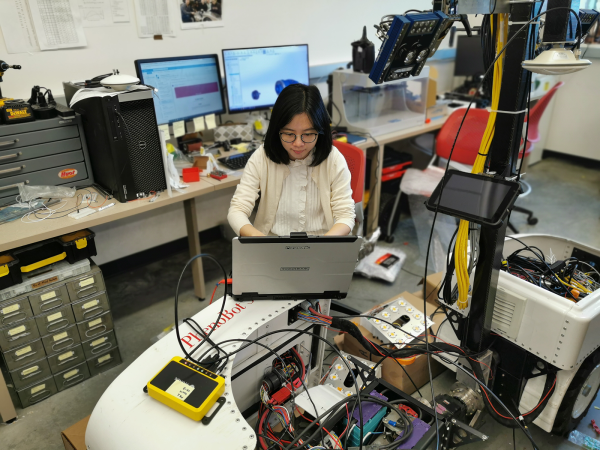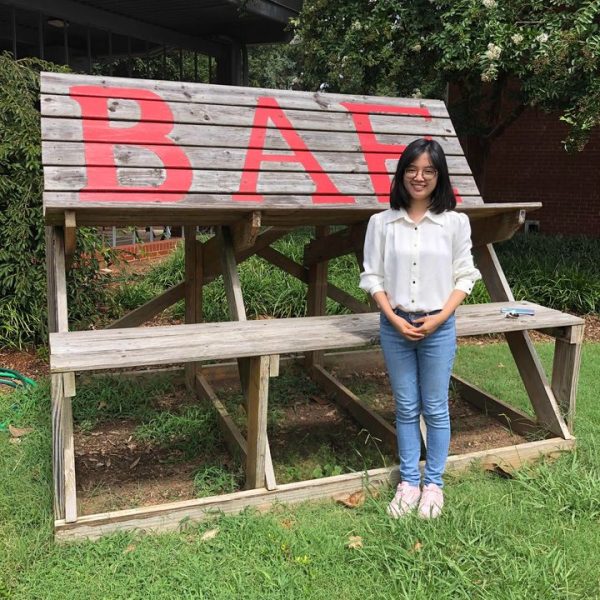The NC State University department known as Biological and Agricultural Engineering began with its roots in agronomy. Its early development is credited largely to David S. Weaver who served as the first department head from 1940 – 1948.
Considered a visionary of his time, he persuaded then UNC President Frank P. Graham of the need for an agricultural engineering department by articulating the plight of farm workers through Jean-Francois Millet’s 19th century painting Man with a Hoe and Edwin Markman’s 1899 poem The Man with the Hoe.

Bowed by the weight of centuries he leans
Upon his hoe and gazes on the ground,
The emptiness of ages in his face,
And on his back the burden of the world.
Markman was inspired by Millet’s painting, which was, and still is, considered symbolic of the laboring class expressed by the arduous work of an unidentifiable farmer.
The department has undergone major developments throughout its history, but its core mission remains the same – engineering sustainable solutions for agricultural, biological, and natural systems to benefit all of humanity.
Welcome new faculty member

Assistant Professor Lirong Xiang is BAE’s newest faculty member specializing in the area of robotics, sensors and control systems. She holds a bachelor in biosystems engineering from Zhejiang University in Hangzhou, China, and most recently, a Ph.D. in agricultural and biosystems engineering from Iowa State University (ISU).
In the span of her postsecondary education, Xiang has published multiple articles, received numerous awards, including an ISU Research Excellence Award and the Reverend P.T. Taiganides Award for Outstanding Ph.D., and helped secure more than $9 million in grants.
This position is Xiang’s first faculty appointment.
“We are very lucky and so excited to have Dr. Lirong Xiang join the faculty of our department. Her passion and motivation for cutting edge research, teaching, and outreach in robotics and sensors is unmatched,” says BAE Professor and Department Head Garey Fox. “She will continue to help our department address the global grand challenges in engineering and agriculture.”
Before stepping into her current role, Xiang was a student, much like those at NC State, exploring subjects that combine her engineering capabilities with her passion for solving problems.
As an undergrad, she elected to involve herself in different research projects for a broader understanding of the agricultural discipline and to learn more about those areas in engineering. For her senior design project, she developed algorithms to reconstruct 3D models and measure morphological traits of lettuce plants using a Microsoft Kinect 3D camera. She also competed in Zhejiang University’s undergraduate robotics competition for an opportunity to attend the American Society of Agricultural and Biological Engineering (ASABE) student robotics competition during its Annual International Meeting (AIM).
Xiang’s first two attempts in the robotics competition at Zhejiang University were not successful, but by the third year she earned top place and would go on to lead a championship team at the ASABE student robotics competition in Orlando, Florida.
“The failure of the first two competitions brought me not only frustration, but more experience and lessons,” she recalls.

In 2017, she began her doctoral studies at ISU where she developed robotic and automated systems for both indoor and in-field plant phenotyping applications. Those systems included a customized camera with a synchronized adjustable baseline and strobe lighting system to improve data collection, a robotic system with a dexterous arm purposefully designed to administer water and monitor plant growth and a specialized software used to analyze image data utilizing deep neural networks. “Every component is very important,” she explains. “The main idea is to reduce labor cost in [plant phenotyping] research.”
She successfully defended her dissertation High-throughput robotic plant phenotyping using 3D machine vision and deep neural networks earlier this year.
Building BAE robotics
Xiang’s ongoing research interests are to develop smart cyber-physical systems that integrate cutting-edge robotics, machine vision, and machine learning technologies to automate labor-intensive tasks in agricultural systems. This is inclusive of global initiatives that are addressing agricultural challenges to meet food supply demands as the United Nations predicts the world population will reach 9.8 billion people by 2050.
“We will need researchers from different disciplines including agricultural engineering, electrical engineering, computer science, computer engineering, and we also need the biological side like plant scientists in genetics and agronomy,” she says. “When we combine those expertise together, we can accomplish larger goals such as finding future crop varieties and improving the crop yield.”
Her future research prospects include developing a robotic system that automatically transplants sweetpotato slips into a feeder, which could be a major economic advantage for producers of one of North Carolina’s largest agriculture commodities. She is also passionate about the application of automation technology in precision livestock farming.

Xiang began her BAE appointment in August. She is the principal investigator of the Automation and Robotics Lab, teaches a course on sensors and controls and has plans to lead the department’s first robotics team.
“The ASABE Robotics Competition provides students with hands-on experience in robotic systems, electronics and sensing technology,” she says.
“I hope that more students will join us in designing fully autonomous robotic solutions for agricultural production processes.”
As part of the team, students will be eligible to compete in the ASABE student robotics competition. The competition requires teams to build a robot that accomplishes a simulated pre-, peri-, or post-harvest agricultural operation. The robots must be fully autonomous and complete the task without human intervention.
Xiang has served as the ASABE robotics student design competition judge and the associate editor for ASABE. “ASABE provides an opportunity to gather all the researchers in this agricultural discipline together and present their research and communicate with each other,” she says. “It also provides a lot of opportunities for students to network and learn what others are doing in this discipline.”
Xiang’s growth mindset combined with her experience and knowledge are an invaluable resource for BAE students interested in entering this rapidly advancing field of study.
Looking forward
“Looking one hundred years backwards from 2031, what will the story be,” Weaver wrote in 1931 of his observations on the history and development of agricultural machinery. “Will the mechanical harvesting of the cotton crop be perfected? Will the airplane supplement the automobile? Will the television aid the telephone? Will there be electricity in every rural home? I think so.”
Looking forward from 2022, what will the story be? Will farms be completely digital and autonomous? Will robots be assisting with all farm operations including harvest crops and monitoring livestock behavior? Will there be enough food to consistently feed global populations all year round? One thing is for sure, BAE aims to make the contributions necessary to help producers achieve all of this and much more.

